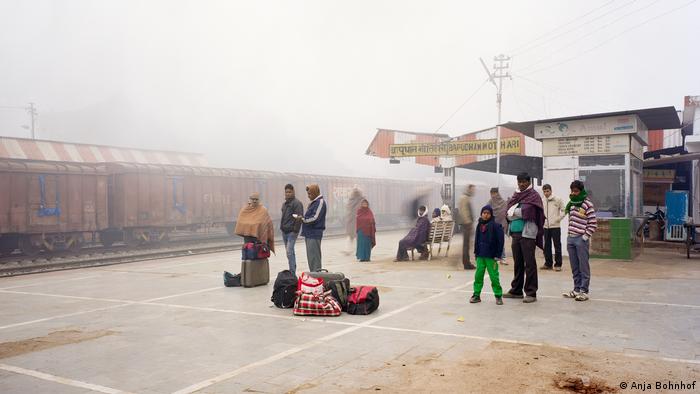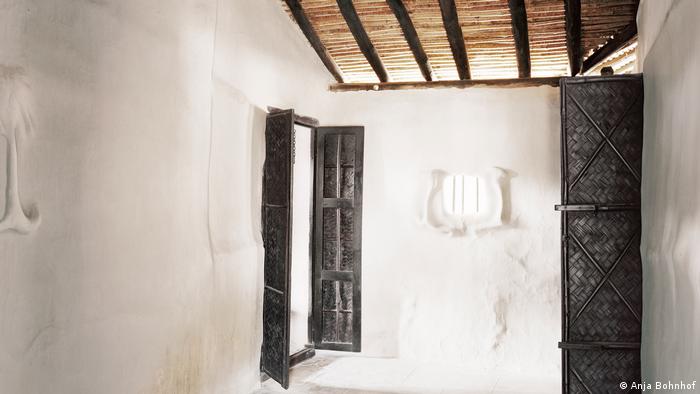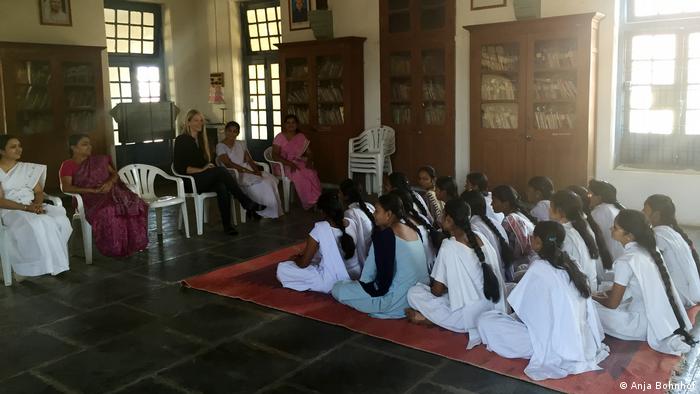Exactly 150 years ago, Mahatma Gandhi came to the world. The German photo artist Anja Bohnhof has to feel the Indian freedom fighters to be meticulously tracked. The result is impressive: “Tracking Gandhi”.
-

“Tracking Gandhi” – In the footsteps of freedom fighter
1893: The Train Station Pietermaritzburg, Waiting Room, Natal, South Africa
On 7. June 1893, shortly after his arrival in South Africa, Gandhi as a
“Non-White” on the journey from Durban to Pretoria from the first class
thrown. The night in the waiting room of the railway station of Pietermaritzburg, the turning point in his life was. Gandhi transformed from a shy lawyer for the activists for the rights of the Indian minority in South Africa.
-

“Tracking Gandhi” – In the footsteps of freedom fighter
1913: common cell in the Central prison of Pretoria, South Africa
Almost six years of his life spent Gandhi for civil disobedience – in the South African and Indian prisons. He used these times productive, studied
and some of the writings is the author of walls within the prison. After his release from prison, Pretoria, on 18. December, 1913, broke Gandhi to India, and left South Africa for ever.
-

“Tracking Gandhi” – In the footsteps of freedom fighter
1917: Motihari Railway Station, Purba Champaran, Bihar, India
Gandhiji’s “Champaran-campaign” led him in 1917 to Bihar – one of the
poorest States in India. Here he supported the small farmers in their struggle against the British landowners imposed required to grow crops of Indigo-plants. After Gandhi’s return from South Africa, this was the first of numerous non-violent protest actions on Indian soil.
-

“Tracking Gandhi” – In the footsteps of freedom fighter
1917/18: Gandhi Adarsh Middle School, Bihar, India
While he was in Champaran for the rights of Indigo farmers, sought Gandhi also to the development of the Region. He followed his Vision of Indian self-government. The school in the small village of Barharwa Lakhansen was one of the first, which he founded in 1917/18 in this Region. Gandhi wanted to fight the illiteracy and the people’s self-esteem gain.
-

“Tracking Gandhi” – In the footsteps of freedom fighter
1919: Navajivan Trust, Archive,, Ahmedabad, Gujarat, India
Gandhi began early on the Power of the media: he edited the weekly “Indian Opinion” was an important voice in the fight against the discrimination of Indians in South Africa. In India, he moved in 1919, in his native language Gujarati is the author of the magazine “Navajivan” (“New life”). More leaves followed you on most economic and social issues.
-

“Tracking Gandhi” – In the footsteps of freedom fighter
1936: Sevagram Ashram, Wardha, Maharashtra, India
From 1936 to 1946 Gandhi lived in Sevagram Ashram at Wardha in Central India. Here he received guests and political sizes from all over the world. His former cabin is preserved almost in its original condition and bears witness to Gandhi’s simple, reduced to the Essential way of life. Gandhi’s Motto was: “My life is my message!”
-

“Tracking Gandhi” – In the footsteps of freedom fighter
1927: Sodepur Ashram, Barrackpore, West Bengal, India
The Sodepur Ashram, North of Kolkata, was founded in 1921 by a Gandhi-activist. Between 1927 and 1947, Gandhi stayed there for a long time and met with leading politicians. From here he broke down at the 6. November 1946
to bring peace to Noakhali on to angry riots between Muslims and Hindus. However, the partition of India was a certainty.
-

“Tracking Gandhi” – In the footsteps of freedom fighter
1946: The Village Of Sadhurkhil, Noakhali, Chittagong District, Bangladesh
In November 1946, traveled Gandhi to Noakhali in today’s Bangladesh,
the grey massacre seeds finish in this area. Background the expected independence of India and the impending division of the country into Muslim and Hindu state areas. At the age of 77 years, Gandhi broke an arduous March for peace through the inaccessible Region in the Ganges-
Delta on.
-

“Tracking Gandhi” – In the footsteps of freedom fighter
1948: Triveni Sangam, Uttar Pradesh, India
After his death on the 30. In January of 1948, Gandhi’s body was
Delhi celebration burned on. A large part of the ash was buried at the confluence of the Ganges with the river Yamuna, and the mythical power Saraswati beige. According to the Hindu Belief, the soul of the deceased goes directly to Nirvana. Smaller quantities of ash were to worship in numerous cities and
Villages of India brought.
-

“Tracking Gandhi” – In the footsteps of freedom fighter
2019: Five Years Of Tracking Gandhi
In your Research to “Tracking Gandhi” visited the Dortmund-based photographer Anja Bohnhof also the Mahila Ashram in India, where young women’s education and craft skills are taught. Bohnhofs image band features a photographic portrait of the Indian freedom fighter Mahatma Gandhi. The National Gandhi Museum in New Delhi displays their works of art starting in October 2019.
Author: Stefan Dege
-

“Tracking Gandhi” – In the footsteps of freedom fighter
1893: The Train Station Pietermaritzburg, Waiting Room, Natal, South Africa
On 7. June 1893, shortly after his arrival in South Africa, Gandhi as a
“Non-White” on the journey from Durban to Pretoria from the first class
thrown. The night in the waiting room of the railway station of Pietermaritzburg, the turning point in his life was. Gandhi transformed from a shy lawyer for the activists for the rights of the Indian minority in South Africa.
-

“Tracking Gandhi” – In the footsteps of freedom fighter
1913: common cell in the Central prison of Pretoria, South Africa
Almost six years of his life spent Gandhi for civil disobedience – in the South African and Indian prisons. He used these times productive, studied
and some of the writings is the author of walls within the prison. After his release from prison, Pretoria, on 18. December, 1913, broke Gandhi to India, and left South Africa for ever.
-

“Tracking Gandhi” – In the footsteps of freedom fighter
1917: Motihari Railway Station, Purba Champaran, Bihar, India
Gandhiji’s “Champaran-campaign” led him in 1917 to Bihar – one of the
poorest States in India. Here he supported the small farmers in their struggle against the British landowners imposed required to grow crops of Indigo-plants. After Gandhi’s return from South Africa, this was the first of numerous non-violent protest actions on Indian soil.
-

“Tracking Gandhi” – In the footsteps of freedom fighter
1917/18: Gandhi Adarsh Middle School, Bihar, India
While he was in Champaran for the rights of Indigo farmers, sought Gandhi also to the development of the Region. He followed his Vision of Indian self-government. The school in the small village of Barharwa Lakhansen was one of the first, which he founded in 1917/18 in this Region. Gandhi wanted to fight the illiteracy and the people’s self-esteem gain.
-

“Tracking Gandhi” – In the footsteps of freedom fighter
1919: Navajivan Trust, Archive,, Ahmedabad, Gujarat, India
Gandhi began early on the Power of the media: he edited the weekly “Indian Opinion” was an important voice in the fight against the discrimination of Indians in South Africa. In India, he moved in 1919, in his native language Gujarati is the author of the magazine “Navajivan” (“New life”). More leaves followed you on most economic and social issues.
-

“Tracking Gandhi” – In the footsteps of freedom fighter
1936: Sevagram Ashram, Wardha, Maharashtra, India
From 1936 to 1946 Gandhi lived in Sevagram Ashram at Wardha in Central India. Here he received guests and political sizes from all over the world. His former cabin is preserved almost in its original condition and bears witness to Gandhi’s simple, reduced to the Essential way of life. Gandhi’s Motto was: “My life is my message!”
-

“Tracking Gandhi” – In the footsteps of freedom fighter
1927: Sodepur Ashram, Barrackpore, West Bengal, India
The Sodepur Ashram, North of Kolkata, was founded in 1921 by a Gandhi-activist. Between 1927 and 1947, Gandhi stayed there for a long time and met with leading politicians. From here he broke down at the 6. November 1946
to bring peace to Noakhali on to angry riots between Muslims and Hindus. However, the partition of India was a certainty.
-

“Tracking Gandhi” – In the footsteps of freedom fighter
1946: The Village Of Sadhurkhil, Noakhali, Chittagong District, Bangladesh
In November 1946, traveled Gandhi to Noakhali in today’s Bangladesh,
the grey massacre seeds finish in this area. Background the expected independence of India and the impending division of the country into Muslim and Hindu state areas. At the age of 77 years, Gandhi broke an arduous March for peace through the inaccessible Region in the Ganges-
Delta on.
-

“Tracking Gandhi” – In the footsteps of freedom fighter
1948: Triveni Sangam, Uttar Pradesh, India
After his death on the 30. In January of 1948, Gandhi’s body was
Delhi celebration burned on. A large part of the ash was buried at the confluence of the Ganges with the river Yamuna, and the mythical power Saraswati beige. According to the Hindu Belief, the soul of the deceased goes directly to Nirvana. Smaller quantities of ash were to worship in numerous cities and
Villages of India brought.
-

“Tracking Gandhi” – In the footsteps of freedom fighter
2019: Five Years Of Tracking Gandhi
In your Research to “Tracking Gandhi” visited the Dortmund-based photographer Anja Bohnhof also the Mahila Ashram in India, where young women’s education and craft skills are taught. Bohnhofs image band features a photographic portrait of the Indian freedom fighter Mahatma Gandhi. The National Gandhi Museum in New Delhi displays their works of art starting in October 2019.
Author: Stefan Dege
They are large-format photographs from offices, rooms, sleep, or prisons. Show some street scenes, city views, or capture entire landscapes. But at least you see people. The pictures of Anja Bohnhofs to beat a calm, narrative tone. No hectic reportage photography, as they would be after the tumultuous, world – shaking life of Mahatma Gandhi (1869-1948) expect. With the book “Tracking Gandhi” is Bohnhof managed a photographic biography, just in time for the 150. Birthday of Gandhi (02.10.2019) where the Indian freedom fighter in the world is thought.

Anja Bohnhof
India, Bangladesh, UK, South Africa – where Gandhi lived and worked, went Bohnhof on the trail. For five years she’s traveled the world and visited and photographed with an analog camera three categories of places: As such, where still today, Gandhi is remembered, such as the birth house or Ashrams in India. Or those whose significance remained unchanged – for example, prisons in South Africa and India, where Gandhi over the years, was imprisoned. And, finally, places with no visible legacy.
Opulent Image Band
With your opulent, bilingual picture book Bohnhof Gandhi traces the path of life. In addition to each image the accompanying texts – the well-researched and combines them with quotes of freedom fighter to an enlightening three sound. “It wasn’t me, therefore, to find Gandhi’s Aura of all the places,” explains the photographer your concept idea, “but it is the only possible approach to Mahatma Gandhi, if you would like to include I the Visual narrative.”

Mahatma Gandhi
To was already during his lifetime, Gandhi, a name with birth name Quotes Karamchand Gāndhī, world-famous. In South Africa, he fought at the beginning of the 20th century. Century against racial segregation and for equal rights of Indians. In India, he led from the end of the 1910s, the local independence movement. Gandhi called for human rights for Dalits (people from the caste of the untouchables, Anm.d.Red.) and for the women. He implored the reconciliation between Hindus and Muslims, fought against the colonial exploitation and for a rural way of life embossed, regional-oriented economic system. Non-violent resistance, civil disobedience and hunger strikes – with such methods of the Indian independence movement of 1947, forced the end of British colonial rule. India was divided. Half a year later, Gandhi was assassinated.

Anja Bohnhof, when Shooting in Johannesburg, South Africa
Several Anja Bohnhof, Born in 1974, the book and exhibition has been realized projects to the Indian subcontinent. Thus, in 2012, “Bahak”, a portrait series created on Indian carrier on the streets of Kolkata’s. In “Krishak” she was accompanied by 2018, the West Bengal small-scale farmers with the rice harvest. The Indian cultural Council awarded her the 2015 award for a German-Indian Engagement. Also, the project “Tracking of Gandhi” that has now culminated in an exhibition. The National Gandhi Museum in New Delhi displays the works of 15. October 2019. The book “Tracking and Gandhi” appeared in the edition of inventio.












